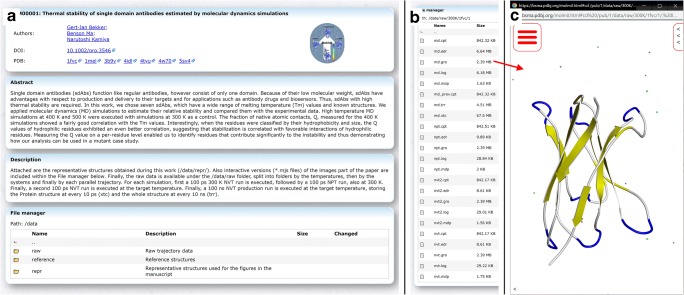Fig. 3.
Published entry BSM-00001 at https://bsma.pdbj.org/entry/1. a In the top panel, the title, graphical abstract, authors, DOI, and links to external databases are listed. Below that, the free-text panels configured by the depositors are shown and finally the file manager, which works as the file manager described in Fig. 1, except no files can be uploaded and no modifications can be made. Here, two methods of annotation are used, first via a free-text panel (named “Description”), which describes the general layout of the uploaded data. Secondly, for the major files and folders, a per-file or per-folder description is included in the “File manager” panel. b List of raw data files included in one of the raw data folders of the entry (https://bsma.pdbj.org/entry/1/path/data/raw/300K/1fvc/1). The input and output files (both ASCII and binary) to/from the MD software were uploaded as is, without any modifications. For this entry, the individual trajectory files (md.xtc) were outputted during the simulation without solvent, making the trajectory files relatively small (albeit that there are 250 such trajectories in this entry). c The file md.gro loaded using the integrated Molmil viewer. In order to load a trajectory file (e.g., md.xtc) from this state, Molmil’s command line must be used, which can be accessed by clicking on the “<” icon in the bottom-left corner. From here, entering the command “load md.xtc” will download and load the file. Finally, to play the trajectory, the “mplay” command can be used

